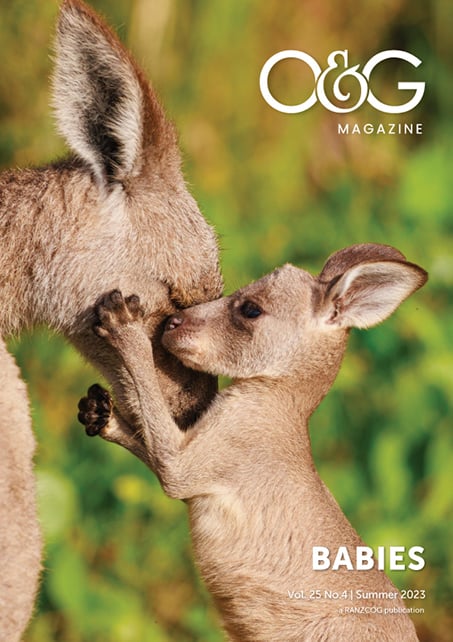With advancements in perinatal and neonatal care, the lower limits of viability have dropped, with many centres in the world now routinely offering resuscitation at 23 and even 22 weeks gestation.1 Importantly, survival rates of extremely premature infants are improving, with some centres of excellence around the world achieving >50% survival in infants born at 22 weeks.2 In addition, a recent meta-analysis of infants born at 22 weeks who received active management found that 37% survived without moderate or severe disability,1 which leads us to question where the limit of viability really lies?
Currently in Australia, only Victoria and Western Australia have published outcome data for infants born at ≤23 weeks. From 2009 to 2017, there were 191 live births at 22 weeks gestation in Victoria, of which only 5% received active management; however, none survived to one year of life. At 23 weeks gestation, 45% of the 260 live births were actively managed and 50% of these infants survived to one year.3 In Western Australia, between 2004 and 2010, there were three survivors at 22 weeks gestation, of whom two went on to have a moderate level of disability while the third had only a mild level of disability at standard follow up. At 23 weeks gestation, 68% of the 44 surviving infants (45.8% survival) were free of moderate or severe disability.4
While Australian data suggests survival at 22 weeks is rare, other countries around the world have demonstrated increased survival over time. In the United Kingdom, 17.9% of live-born infants at 22 weeks gestation from 2008 to 2014 survived to discharge and crude survival of 22–23 week infants rose by an average of 6% over the study period.5 In Sweden, survival rates of live born infants at 22 weeks rose from 10% during their first study epoch to 39% in the most recent epoch from 2017 to 2019. Of surviving infants at 22 weeks, approximately 20% did not have major neonatal morbidities (eg severe intraventricular haemorrhage, surgical necrotising enterocolitis).6 Interestingly, the proportion of live-born infants admitted to a neonatal intensive care unit (NICU) was higher in both these studies compared with Australian data, which suggests that our approach to extreme prematurity is more conservative.
In centres that routinely resuscitate infants ≤23 weeks, prenatal factors such as steroid administration and birth in a tertiary hospital are key factors that reduce infant mortality and morbidity.1,2 Appropriately timed steroids accelerate fetal lung maturation and reduce the rate of intraventricular haemorrhage7,8 and necrotising enterocolitis;8 the combined effects leading to a reduction in mortality in the extremely preterm population.7–11 Unfortunately, the majority of evidence for steroids in infants at 22–23 weeks comes from observational data as less than 50 infants under 26 weeks were included in the original clinical trials of antenatal steroids.7 Nevertheless, the timely administration of steroids is crucial if resuscitation of this highly vulnerable group is to be considered. In addition, birth in a tertiary centre has been shown to significantly improve the chances of survival to one year in extremely preterm infants (adjusted odds ratio 2.78), as well as decrease the risk of long-term disability.12 Therefore, timely in utero transfer of mothers considering active resuscitation of an extremely preterm infant is essential. This might necessitate discussions with neonatal retrieval services to provide telehealth counselling to at-risk women in order to ensure the right women are being transferred for consideration of neonatal care.
What does this mean for clinicians counselling women at risk of delivering an extremely preterm infant? Unfortunately, there is no standard approach to these extremes of viability, therefore thorough discussions with the parents and an understanding of local data becomes crucial. Experts advocate for a shared decision-making model where the parents’ values and beliefs can be incorporated into the management plan for the delivery.13 However, this should not come at the cost of providing a realistic picture of the risks of preterm delivery at a given gestation. Currently in Australia, guidelines recommend palliation at gestations <23 weeks. However, Safer Care Victoria has recently moved to include infants born at 22 weeks gestation within the ‘zone of parental discretion’ and suggests that resuscitation can be offered to these infants in some circumstances.14 When taking the parents’ perspectives into account it is worth noting that previous studies have shown that while most parents acknowledge the difficulty of giving birth to an extremely preterm infant, the majority also recognise the positive impact the experience has had on their family life.15
It is important to note that the decision to resuscitate an infant at birth and provide antenatal corticosteroids does not preclude the parents from the decision to withdraw care at a later date if significant morbidity occurs in the neonatal period. Nor does the decision to actively manage an infant at birth and subsequently offer withdrawal of care due to changing clinical condition provide additional ethical challenges. By engaging in a shared decision-making paradigm, parents and clinicians can continually re-evaluate the infant’s clinical picture with the aim of making ongoing decisions in the best interest of the child.
While the resuscitation of infants at 22–23 weeks gestation remains controversial, what is clear is that the limits of viability have already shifted and with advances in perinatal and neonatal care the grey zone of viability might continue to decrease. Clinicians should consider multiple factors when confronted with the possible delivery of an extremely preterm infant. What are the positive prognostic factors? What are the parents’ wishes? Is our centre the best place for delivery or should maternal transfer be offered? How can we optimise the situation for this baby and family – have we given steroids? The answers to these questions should help guide the clinicians’ course of action in lieu of strict gestational age criteria and in time we might find that the limits of viability are less defined than previously thought.
Further information
References
- Backes CH, Rivera BK, Pavlek L, et al. Proactive neonatal treatment at 22 weeks of gestation: a systematic review and meta-analysis. Am J Obstet Gynecol 2021;224(2):158–174. doi:10.1016/j.ajog.2020.07.051
- Rysavy MA, Mehler K, Oberthür A, et al. An immature science: intensive care for infants born at ≤23 weeks of gestation. J Pediatr 2021;233:16-25.e1. doi:10.1016/j.jpeds.2021.03.006
- Boland RA, Cheong JLY, Stewart MJ, Doyle LW. Temporal changes in rates of active management and infant survival following live birth at 22–24 weeks’ gestation in Victoria. Aust N Z J Obstet Gynaecol 2021;61(4):528–535. doi:10.1111/ajo.13309
- Sharp M, French N, McMichael J, Campbell C. Survival and neurodevelopmental outcomes in extremely preterm infants 22–24 weeks of gestation born in Western Australia. J Paediatr Child Health 2018;54(2):188–193. doi:10.1111/jpc.13678
- Santhakumaran S, Statnikov Y, Gray D, et al. Survival of very preterm infants admitted to neonatal care in England 2008–2014: time trends and regional variation. Arch Dis Child Fetal Neonatal Ed 2018;103(3):F208–F215. doi:10.1136/archdischild-2017-312748
- Farooqi A, Hakansson S, Serenius F, et al. One-year survival and outcomes of infants born at 22 and 23 weeks of gestation in Sweden 2004–2007, 2014–2016 and 2017–2019. Arch Dis Child Fetal Neonatal Ed. Epub 2023 Jun 8. doi:10.1136/archdischild-2022-325164
- Roberts D, Brown J, Medley N, Dalziel SR. Antenatal corticosteroids for accelerating fetal lung maturation for women at risk of preterm birth. Cochrane Database Syst Rev 2017;3(3):CD004454. doi:10.1002/14651858.CD004454.pub3
- Chawla S, Natarajan G, Shankaran S, et al. Association of neurodevelopmental outcomes and neonatal morbidities of extremely premature infants with differential exposure to antenatal steroids. JAMA Pediatr 2016;170(12):1164–1172. doi:10.1001/jamapediatrics.2016.1936
- Rysavy MA, Bell EF, Iams JD, et al. Discordance in antenatal corticosteroid use and resuscitation following extremely preterm birth. J Pediatr 2019;208:156–162.e5. doi:10.1016/j.jpeds.2018.12.063
- Ehret DEY, Edwards EM, Greenberg LT, et al. Association of antenatal steroid exposure with survival among infants receiving postnatal life support at 22 to 25 weeks’ gestation. JAMA Netw Open 2018;1(6):e183235. doi:10.1001/jamanetworkopen.2018.3235
- Park CK, Isayama T, McDonald SD. Antenatal corticosteroid therapy before 24 weeks of gestation: a systematic review and meta-analysis. Obstet Gynecol 2016;127(4):715–725. doi:10.1097/AOG.0000000000001355
- Boland RA, Davis PG, Dawson JA, Doyle LW. Outcomes of infants born at 22–27 weeks’ gestation in Victoria according to outborn/inborn birth status. Arch Dis Child Fetal Neonatal Ed 2017;102(2):F153–F161. doi:10.1136/archdischild-2015-310313
- Arnolds M, Laventhal N. Perinatal counseling at the margin of gestational viability: where we’ve been, where we’re going, and how to navigate a path forward. J Pediatr 2021;233:255–262. doi:10.1016/j.jpeds.2021.02.006
- Safer Care Victoria. Extreme prematurity. Melbourne: Safer Care Victoria; 2021 [updated 27 August 2021; accessed 17 September 2023]. Available at safercare.vic.gov.au/clinical-guidance/neonatal/extreme-prematurity#goto-newguidance-on-extreme-prematurity
- Luu TM, Pearce R. Parental voice – what outcomes of preterm birth matter most to families? Semin Perinatol 2022;46(2):151550. doi:10.1016/j.semperi.2021.151550







Leave a Reply